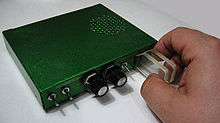High-speed telegraphy
Fast telegraphy is Morse code telegraphy with particularly high speeds.
definition
The speed of telegraph messages is measured in BPM (letters per minute) or WPM (words per minute). In Germany, the PARIS standard is used: If you send the word PARIS 30 times in exactly one minute, the speed is 30 WPM or 150 BPM. This corresponds to a duration of 40 milliseconds for a point and 120 milliseconds for a line. Since dashes are three times as long as dots, the word PARIS, including character and word spacing, consists of 50 dot lengths. A speed of 30 WPM corresponds to 1500 point lengths in 60 seconds and thus a point length of 40 ms.
In America the CODEX standard is used. To convert from the PARIS standard, divide by 1.2.
In Switzerland the VVVVV standard is used. To convert from the PARIS standard, divide by 1.28.
Automatic buttons
To make sending easier, mechanical semi- automatic Morse code keys or electronic automatic Morse code keys are used. Semi-automatic keys give multiple points automatically with a pendulum, while strokes are given by hand. Electronic keys also automatically give stroke sequences. Professional radio services, such as coastal radio stations , also sent telegrams with automatic transmitters from punched tape .
Records
The American military radio operator and radio amateur Harry Abner Turner (1906-1994, amateur radio call sign W9YZE) with a keying speed of 175 characters per minute (about 35 WpM) in 1942 is the record holder for giving with the hand key. International ear reading competitions for radio amateurs are organized by the International Amateur Radio Union . The fastest telegraph operator was the American Theodore Roosevelt McElroy (1904–1963) in 1939 with a speed of 75.2 WPM (about 376 bpm) and in 1954 Fyodor Vasilyevich Roslyakov (1918–1972) from the Soviet Union with 88 WPM (about 440 bpm).
Individual evidence
- ↑ Joachim Beckh: Blitz & Anker: Information Technology - History and Backgrounds, Volume 1. Books on Demand, Norderstedt 2005, p. 350.
- ^ Lewis Coe: Wireless Radio: A Brief History. McFarland, Jefferson NC 1996, p. 139.
- ↑ World's record established in code receiving. In: The Asheville Times , July 3, 1939.
- ↑ Georgij Tschlijanz (Георгий Члиянц) (UY5XE): Origin and development of the radio enthusiast movement. ( RTF , 947 kB) p. 30 f. , accessed on November 27, 2012 (Fyodor Wassiljewitsch Roslyakov is called Fedor Roslyakov in the romanization).
- ↑ IA Demjanow, IV Kazansky : Радиоспорт в СССР. Energija, Moscow 1979, p. 42.

